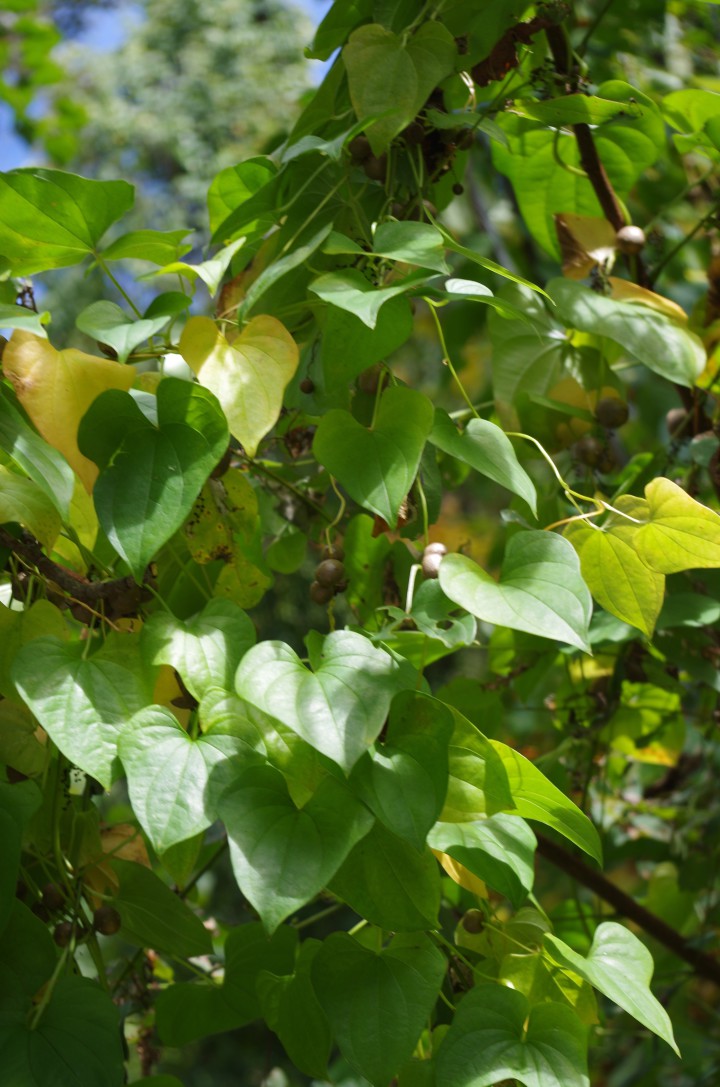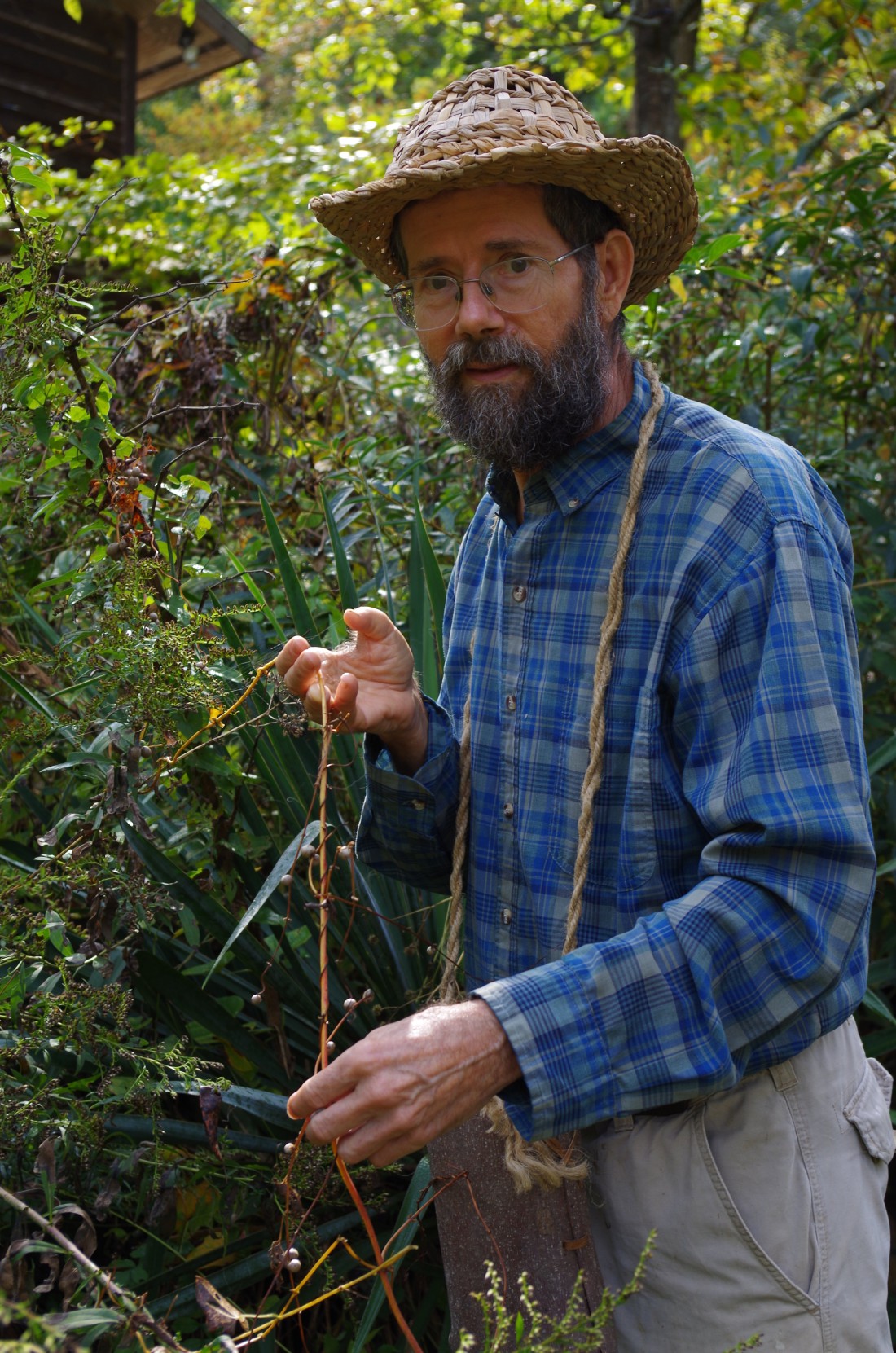On a recent tour with wild foods educator Alan Muskat, our group stumbles upon what looks like tiny potatoes growing on vines. “I call these fairy potatoes,” Muskat says, popping one of the marble-sized tubers into his mouth. “It’s a wild yam, technically. … It’s commonly known as cinnamon vine. … You can cook them like potatoes. If you have kids, you can make fairy french fries.”
The next day, as I turn a corner in my neighborhood, I literally run into the same plant. I roast some of the tiny, vine-growing tubers in the oven with olive oil and salt, and they are delicious. An Internet search on cinnamon vine, however, clouds my enthusiasm. Descriptions of the air potato, as it’s more often known, include phrases like “invasive” and “possibly poisonous,” giving me pause about consuming my curious bounty.
I write to Muskat for clarification. Dioscorea polystachya, he replies, is the local, edible variety — not to be confused with the D. bulbifera that plagues folks in Florida.
Muskat points me in the direction of local herbalist and storyteller Doug Elliott, who writes in his book Wild Roots that the air potato was originally brought here as an ornamental plant from China and is also called Chinese yam. The name cinnamon vine comes from its small, white cinnamon-scented flowers that bloom in midsummer.

At his homestead in Union Mills, Elliott tells me that cinnamon vine also has delicious tubers under the ground, but he and his wife mostly use the vine-growing air potatoes, either boiling them like regular potatoes or rolling them around in a hot, well-oiled frying pan.
Elliott, author of such works as the children’s collection Crawdads, Doodlebugs & Creasy Greens, knows songs and stories about all kinds of plants, but none for the air potato — yet. Elliott does, however, point me in the direction of his friend Clyde Hollifield, whom he describes as a “folkloric character.” He says Hollifield has a story about the air potato being the potato of “the little people.”
“The little people?” I ask. But Elliott says I should hear the story from Hollifield himself.
The Little People
Hollifield lives some 18 winding miles southeast of Black Mountain and introduces himself as a local person who’s been “grandfathered in.” A former instrument builder, puppeteer, community college instructor and rehabilitator of birds of prey, Hollifield is full of neat tricks, like making a miniature rain jacket out of a poplar leaf and fitting a hand-carved miniature dulcimer magically into a bottle.
“The little people’s potato,” he says of the air potato. He, too, has the aerial-tuber-dotted vine growing on his property some meters up from a replica of Stonehenge. “‘Cause it’s so tiny, you know what I mean? But it’s so small that it would have to be the potato of the second little people down.”
I tell Hollifield that I am unfamiliar with the idea of the little people. “Are they like fairies?” I ask.
Not exactly, he says, explaining that the small figures from Cherokee lore were thought to be more like people. “They had the same lifestyle, but were mythological, I guess you’d say, or magical.”
Hollifield points out that in European folklore, there’s a whole menagerie of mythological creatures, like trolls, goblins, elves and hobbits, who, like the Cherokee little people, are said to have lived underground, in rock piles or in other in-between places.
This is no idle chatter. One of Hollifield’s stories appears in a book on Cherokee little people, and he himself has written and illustrated an impressively detailed fantasy manuscript called The Cedar Creek Fairies that draws from local ecology.
The Cherokee name for air potatoes is nuni, says Hollifield. He’s not sure how long the plant has been here, but he’s sure the Cherokee knew about them.
“I probably made up the connection between the nuni and the little people,” admits Hollifield. Still, he explains, in Cherokee and many other native cultures, little things are more important than big things. Folk wisdom holds that the little medicine, the little root, for instance, is strongest. This general rule applies to many things — among them, certainly, the little people.
“They were allies, in a different realm,” says Hollifield. “It wasn’t necessarily good to see them. It might be dangerous.”
I think back to the tour with Muskat, where I first encountered the air potato. “Fairy potatoes,” he told us, with a half-smile. “A name I made up, but it’s a little bit dangerous, right?”
As with picking wild food in general, my search for information on the air potato seems something of a shadowy treasure hunt. Each person I encounter along the way seems to shun the well-beaten path, purposefully veering outside the mainstream in order to access something richer.
Chinese Roots
After visiting Elliott and Hollifield, I make an appointment to interview Dongping Han. A professor of Chinese history and political science at Warren Wilson College, Han is a man to whom the air potato is no mystery. He grew up with this plant in China and now grows it in his yard, boiling the air potatoes in season and eating them as a snack.
“When I was growing up, this was one of one of most important plants my family grew,” Han says. In China, it’s renowned for its healing properties as well as for food.
The tiny, vine-growing air potatoes are dipped in sugar, cooked and sold on a stick during New Year time, says Han. But it’s the underground tuber of the plant that’s prized among the Chinese as a foodstuff. Cooked with chicken, it is a favored dish for important guests.
“If you read the Chinese medical book, it’s good for anything almost,” Han says about the yam. It has a sweet, neutral nature that is said to be beneficial for the kidney and the spleen and help balance chi within the body.
Since the root can grow to be up to 6 feet long, it is sometimes cultivated in a tube or pipe for easier harvesting. “If you cook the root,” says Han, “once you take the skin off, it’s very sticky, and slippery. The Chinese believe that anything like that is good for your health.”
Han says the air potato is found all over China. He is not aware of any poisonous varieties.
So perhaps, I think, the shadowy treasure hunt ends here.
“What’s the name of the air potato in Chinese?” I ask. Shan yao, Han says, spelling it for me. Shan means mountain; yao means medicine. When I look that up on the Internet, I get another surprise.
Due to its use as a tonic for both “congenital and acquired ailments,” several sources say, the Chinese apparently have another name for this superstar mountain yam: fairy food.
And no, I’m not making this up.
A version of this story was originally published on Carla Seidl’s blog, earthflavors.net.




Before you comment
The comments section is here to provide a platform for civil dialogue on the issues we face together as a local community. Xpress is committed to offering this platform for all voices, but when the tone of the discussion gets nasty or strays off topic, we believe many people choose not to participate. Xpress editors are determined to moderate comments to ensure a constructive interchange is maintained. All comments judged not to be in keeping with the spirit of civil discourse will be removed and repeat violators will be banned. See here for our terms of service. Thank you for being part of this effort to promote respectful discussion.